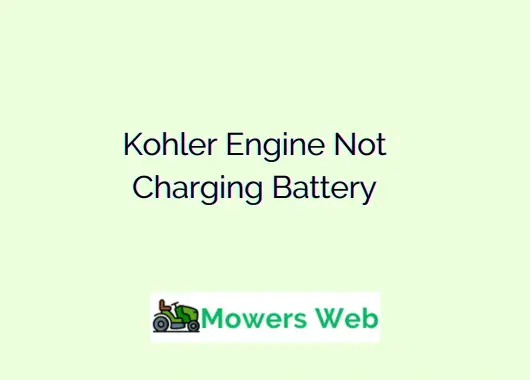If you’re experiencing issues with your Kohler engine not charging the battery, you’re not alone.
This common problem can be frustrating, but with some troubleshooting and a basic understanding of the charging system, you can get your engine back in working order.
In this article, we’ll guide you through the possible reasons behind this issue and provide step-by-step solutions to resolve it.
Let’s jump in.
Kohler Engine Not Charging Battery
Common Reasons for Battery Not Charging
1. Faulty Alternator
A faulty alternator is a common culprit when your battery isn’t charging. If the alternator isn’t generating enough power or is completely dead, the battery won’t receive the charge it needs to function.
2. Worn-out Drive Belt
The drive belt plays a crucial role in transferring energy from the engine to the alternator. If it’s worn out, damaged, or loose, the alternator won’t be able to generate enough power to charge the battery.
3. Malfunctioning Voltage Regulator
The voltage regulator regulates the output voltage from the alternator to prevent overcharging or undercharging of the battery. A malfunctioning voltage regulator can disrupt this balance and lead to battery charging issues.
Tools You’ll Need
Before you start troubleshooting, gather the following tools:
- Wrench set
- Multimeter
- Screwdriver
- Replacement parts (alternator, drive belt, voltage regulator)
Read Kohler Engine Starving for Fuel(5 Quick Ways To Fix)
Troubleshooting Kohler Engine Not Charging Battery
Step 1: Check the Battery connections.
Ensure that the battery terminals are clean and tightly connected. Corroded or loose connections can interfere with the charging process.
Step 2: Inspect the Drive Belt
Examine the drive belt for signs of wear, damage, or tension issues. Replace the belt if necessary, and adjust the tension according to the manufacturer’s specifications.
Step 3: Test the Alternator Output
Use a multimeter to measure the output voltage of the alternator. Compare the reading to the manufacturer’s recommendations. If the output is below the recommended range, the alternator may need replacement.
Step 4: Examine the Voltage Regulator
Test the voltage regulator’s functionality using a multimeter. If it’s not regulating the voltage properly, consider replacing it.
Read Kohler V-Twin Oil Leak(5 Quick Ways To Fix)
DIY Solutions to Charging Problems
Alternator Replacement
If the alternator is confirmed to be the issue, replace it with a new one. Follow the manufacturer’s guidelines for installation.
Drive Belt Replacement
Replace a worn-out or damaged drive belt to ensure proper energy transfer. Adjust the tension according to the specifications.
Voltage Regulator Replacement
Replace a malfunctioning voltage regulator to restore proper voltage regulation.
When to Seek Professional Help
If you’re unsure about the diagnosis or uncomfortable performing the repairs yourself, it’s wise to seek assistance from a professional mechanic.
Read Kohler V-Twin Throttle Linkage(3 Quick Ways To Fix)
Kohler Command 25 not charging
Common Symptoms of Charging Problems:
- Dimming headlights and lights
- Difficulty starting the engine
- Frequent need to jump-start the battery
- Battery not holding charge
- Electrical accessories are not functioning properly.
Troubleshooting Steps
Step 1: Inspect Battery Connections
Check for loose or corroded battery terminals. Clean the terminals and ensure secure connections.
Step 2: Check the drive belt condition.
Examine the drive belt for signs of wear, damage, or tension issues. Replace if necessary.
Step 3: Test Charging Output
Use a multimeter to measure the output voltage of the alternator. Compare it with the manufacturer’s specifications.
Step 4: Examine the Voltage Regulator
Test the voltage regulator’s functionality using a multimeter. Replace it if it’s not regulating the voltage properly.
Step 5: Inspect Wiring and Connections
Inspect the wiring for any frayed, damaged, or disconnected wires. Ensure all connections are tight and secure.
Read Kawasaki Charging System Troubleshooting(Solved)
Possible Solutions
1. Battery Terminal Cleaning
Clean the battery terminals to ensure a strong connection and proper charging.
2. Drive Belt Replacement
Replace the drive belt if it’s worn out or damaged to restore energy transfer.
3. Alternator Repair or Replacement
If the alternator is faulty, consider repairing or replacing it to ensure proper charging.
4. Voltage Regulator Replacement
Replace a malfunctioning voltage regulator to maintain consistent voltage levels.
5. Wiring and Connection Repair
Repair or replace damaged wiring, and ensure all connections are secure.
Read Will a Lawn Mower run with a Dead Battery(What To do)
Preventive Measures to Maintain the Charging System
Regularly clean and inspect the charging system components to prevent issues. Additionally, perform routine battery maintenance, such as cleaning terminals and checking electrolyte levels.
Final Remarks
A Kohler engine not charging the battery can be a troublesome situation, but by following the outlined troubleshooting steps and solutions, you can diagnose and resolve the problem.
Remember to prioritize safety and consider seeking professional help if needed. By maintaining your engine’s charging system, you ensure reliable performance and a longer lifespan for your equipment.
Read Kohler Engine Dies After 30 Minutes(7 Quick Ways To Fix)
FAQs
How often should I inspect my Kohler engine’s charging system?
It’s recommended to perform a visual inspection every few months and a more comprehensive check annually.
Can I use a multimeter to test the alternator’s output?
Yes, a multimeter is a valuable tool for measuring alternator output and diagnosing charging issues.
What causes a voltage regulator to malfunction?
Voltage regulators can fail due to wear and tear, electrical issues, or manufacturing defects.
Can I replace the drive belt myself?
If you’re comfortable working with engines, you can replace the drive belt following the manufacturer’s instructions.
Is battery maintenance important even if my engine is running fine?
Yes, regular battery maintenance helps prolong its life and prevent unexpected charging problems.




